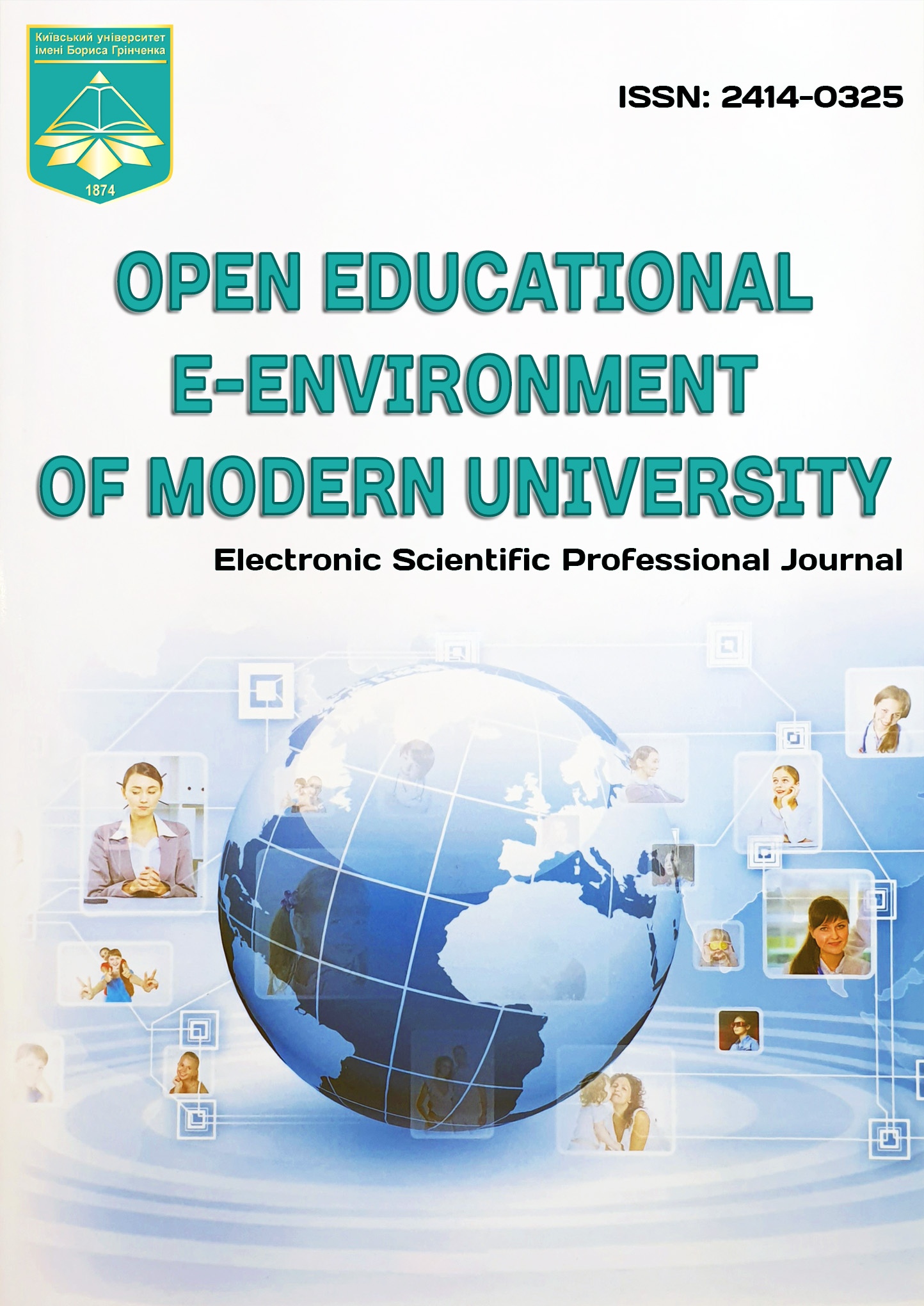КРИТЕРІЇ ТА ПОКАЗНИКИ КОМПОНЕНТІВ ГОТОВНОСТІ МАЙБУТНІХ УЧИТЕЛІВ ПРИРОДНИЧО-МАТЕМАТИЧНИХ ДИСЦИПЛІН ДО ВИКОРИСТАННЯ ТЕХНОЛОГІЙ ВІЗУАЛІЗАЦІЇ У ОСВІТНЬОМУ ПРОЦЕСІ
DOI:
https://doi.org/10.28925/2414-0325.2019.7.13Ключові слова:
підготовка майбутнього вчителя, компоненти готовності, природничо-математичні дисципліни, технології візуалізації, критерії та показники готовностіАнотація
У статті висвітлено компоненти готовності майбутнього вчителя природничо-математичних дисциплін до застосування технологій візуалізації в освітньому процесі загальноосвітньої школи (мотиваційно-ціннісний, когнітивний, операційно-діяльнісний, практично-діяльнісний, рефлексивно-оцінювальний). Відповідно до окреслених компонентів встановлено критерії та окреслено показники через які відбиваються відповідні критерії. До показників мотиваційно-ціннісного критерію віднесено прагнення до: усвідомлення значущості використання технологій візуалізації в освітньому процесі; подолання труднощів і вольових зусиль у процесі запровадження технологій візуалізації в навчальному процесі; зацікавленості отримання знань, умінь і навичок щодо опанування нового інструментарію технологій візуалізації та освоєння нових форм навчання із застосуванням зазначених технологій; проявлення креативності в рішенні професійних завдань. Когнітивний критерій представлено показниками щодо знань: психологічних та вікових особливостей сприйняття учнями візуальних матеріалів; дидактичного потенціалу технологій візуалізації; методів і правил структурування, ущільнення та принципів розподілення навчального матеріалу; основ дизайну (правила і прийоми композиції і колористики); класифікації онлайнових інструментів візуалізації щодо застосування в навчальному процесі; системи вимог, якій повинна відповідати візуалізація, що використовується в освітньому процесі. До показників операціонально-інструментального критерію нами віднесені вміння: ефективного подання навчального матеріалу шляхом створення когнітивних візуальних якорів та візуальних метафор; зберігати отриману та перероблену візуальну інформацію у відповідній формі; передавати інформацію для колективного використання чітким візуальним способом і у різних візуальних форматах; створювати власні візуальні матеріали; застосовувати систему вимог до створення візуального контенту; володіти широким спектром інструментарію. Практично-діяльнісний критерій представлено вмінням: використовувати технології візуалізації в процесі проектування уроку, здійснювати адаптацію готових дидактичних візуальних засобів до змісту і мети уроку, контингенту учнів; створювати предметні завдання на готових візуальних матеріалах тощо; аргументовано визначати педагогічну доцільність застосування технологій візуалізації на уроці; організовувати навчальну, дослідницьку, рефлексивну та іншу діяльність учнів з їх використанням; забезпечувати надання учням допомоги, адекватної їх потребам. Останнім критерієм є рефлексивно-оцінювальний, який передбачає критичну оцінку: доцільності форм і методів навчання на базі технологій візуалізації щодо їхнього застосування в освітньому процесі; якості власної підготовки до застосування технологій візуалізації у навчальному процесі і визначенні шляхів вдосконалення цієї підготовки; здійсненні моніторингу нових методів, інструментів для створення візуальних матеріалів; систематичної корекції власної підготовки до застосування технологій візуалізації у предметному навчанні.
Завантаження
Посилання
Bilousova, L. & Zhytienova, N. (2018). Components of the readiness of future teachers of natural and mathematical disciplines to use visualization technologies in the subject-professional activity. Naukovi zapysky Ternopiljsjkogho nacionaljnogho pedaghoghichnogho universytetu imeni Volodymyra Ghnatjuka. Serija: pedaghoghika, Vol. 3, 80-87 (in Ukrainian)
Karpov, A. (2003). Reflexivity as a mental property and methodology for its diagnosis. Psihologicheskij zhurnal, Vol. 24 (5). (in Russian)
Sergiyenkova, O. (2009). Educational psychology
libfree.com (in Ukrainian)
Skulysh, N. (2013). Methods of measuring creative activity and revealing the level of development of creative thinking of professional self-determination of university students. Problemy suchasnoyi psyxologiyi. Kamyanecz-Podilskyj: «Aksioma», Vol. 20, 611-621 (in Ukrainian)













1.jpg)








